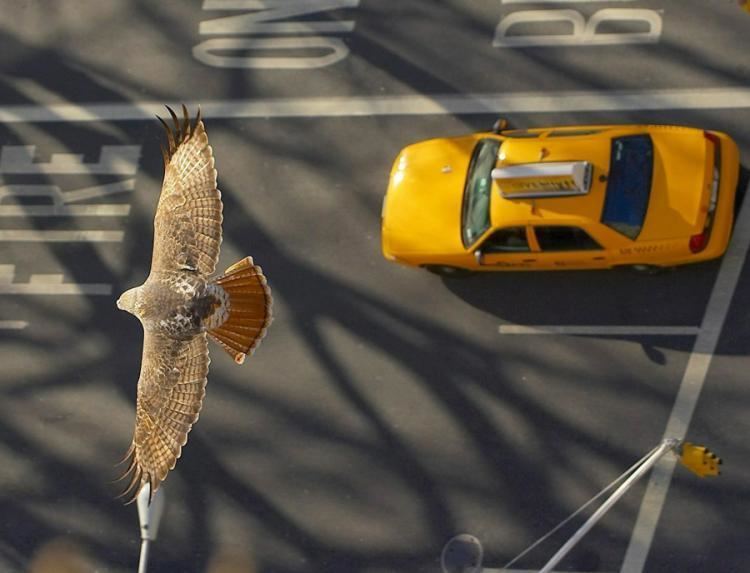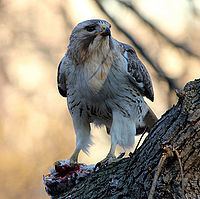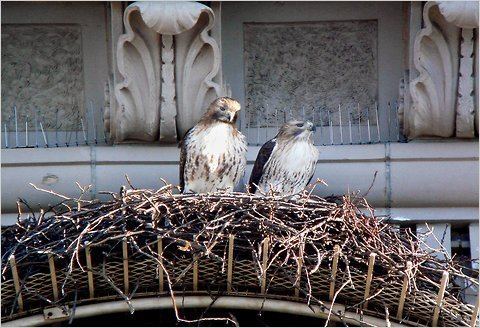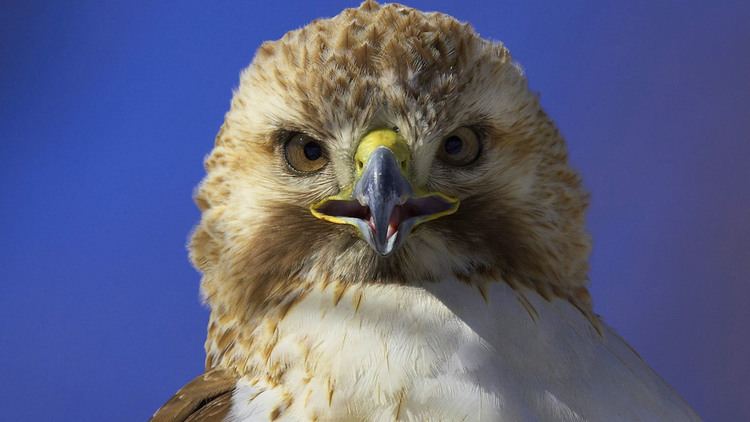Species Buteo jamaicensis | ||
 | ||
Known for Nesting on a Fifth Avenue building Partner(s) First Love (1992, cir. 1995-1997)Chocolate (cir. 1992-1995)Blue (1998-September 11, 2001)Lola (2002-December 2010)Lima (on-and-off; early 2011-February 25, 2012)Paula (2011) Zena (2012)Octavia (2012-present) | ||
Pale male and octavia switch places
Pale Male /peɪl meɪl/ (hatched in 1990) is a red-tailed hawk who has resided since the 1990s near New York City's Central Park. Birdwatcher and author Marie Winn gave him his name because of the unusually light coloring of his head. He is one of the first red-tailed hawks known to have nested on a building rather than in a tree and is known for establishing a dynasty of urban-dwelling red-tailed hawks. Each spring, bird watchers set up telescopes at the Model Boat Pond to observe his nest and chicks at 927 Fifth Avenue.
Contents
- Pale male and octavia switch places
- Life
- Nest controversy
- Other red tailed hawks in the area
- In popular culture
- References

Life

When he arrived in Central Park in 1991, as a first-year immature hawk, Pale Male tried to nest in a tree, but he was driven off by crows. He later roosted on a building on Fifth Avenue across the street from the park. Around early 1992, he found a mate, dubbed "First Love". First Love was injured later that year and removed to the Raptor Trust in New Jersey. During her absence, Pale Male took another mate, named Chocolate. After several unsuccessful spring nesting attempts, Pale Male and a mate, possibly Chocolate, hatched 3 eyasses in 1995. The eyasses survived to young adulthood and took up residence in Central Park. Chocolate died later that year from injuries from a collision with a car on the New Jersey Turnpike.

First Love returned to Central Park after being banded and released from the Raptor Trust. She and Pale Male reunited and raised several eyasses. Some birdwatchers waited several months to see the eyasses grow and then take their first flights. Pale Male brought food to his offspring about five times each day. In 1997, First Love died after eating a poisoned pigeon in Central Park.

Pale Male's mate from 1998 to 2001 was a hawk known as Blue. The pair were observed to hatch about 11 eyasses in that period. Blue disappeared about the time of the September 11 attacks in 2001. In early 2002, Pale Male was first observed with a new mate, Lola. They raised 7 eyasses between 2002 and 2004, building a nest on ornamental stonework above a top-story window on a residential housing cooperative at 927 Fifth Avenue (at East 74th Street) on the Upper East Side of Manhattan. Lola disappeared in December 2010 and is presumed dead.

A new mate appeared in early January 2011. This new hawk, Lima (also called "Ginger", because of her dark feathers on her neck and chin), was only in her second year. She was a young adult, with still-yellow irises, indicating her exact age. Her first nesting attempt was in the winter and spring of 2011 using the existing nest. Ginger exhibited behavior consistent with incubation of eggs in mid-April 2011 and two eyasses emerged towards the end of May 2011, producing the first baby hawks in this nest since 2004. Lima died in late February 2012, presumably from a poisoned rat.

After Lima's death, Pale Male took a new mate, dubbed Zena. The two fledged 3 offspring, two of which were poisoned, rescued, rehabilitated, and then released back into Central Park. In September 2012 Zena disappeared and was presumed dead, and Pale Male took a new mate, called "Octavia" due to her status as Pale Male's eighth mate.
Nest controversy
In December 2004, the hawks' nest and the anti-pigeon spikes that had long anchored it were removed by the board of the co-op. The removal caused an international outcry and a series of impassioned protests organized by New York City Audubon Society and the Central Park birding community. Mary Tyler Moore, a resident of the building, also participated in the protests. On December 14, 2004, the building, various city agencies, and the Audubon Society came to an agreement to replace the spikes and to install a new "cradle" for the nest. By December 28, 2004, the scaffolding had been removed and the hawks started bringing twigs to the nest site.
However, eggs laid by Lola in March 2005 did not hatch, and in fact Pale Male and Lola did not hatch any new eyasses since the disturbance of their original nest. A panel of experts assembled by the Audubon Society reviewed the photos taken of the interior of the nest on January 4, 2008, and recommended the removal of stainless steel spikes seen protruding through the bowl of the nest. The spikes impede the rolling of the eggs by the female during incubation. The Audubon Society obtained the support and approvals of municipal agencies and property owners to have the 92 spikes removed from the cradle supporting the nest.
Although news reports in early summer 2006 suggested that Pale Male and Lola had given up on their Fifth Avenue nest in favor of a location on the Beresford apartments across the park on Central Park West, this was not the case. The hawks regularly perched on the Beresford and may have roosted there at night, but they continued to return to the Fifth Avenue location during nesting season.
Other red-tailed hawks in the area
At the south end of the park, a hawk couple dubbed Pale Male Junior (or simply "Junior") and Charlotte nested on the Trump Park hotel on Central Park South in 2005 and successfully raised two eyasses. For two years, their nest was on a building on Seventh Avenue at 57th Street (two blocks south of the park), after which Junior and Charlotte left the area. Following reports of red-tails attempting to nest on or near the Plaza Hotel at the southeast corner of Central Park, a pair of red-tails built a nest in a tree on the edge of the park's Sheep Meadow in 2014 and raised two baby hawks.
A hawk couple known as Tristan and Isolde claimed Central Park's Great Hill and North Wood as their territory in 2006, but their nest was located about four blocks from the park at the Cathedral of St. John the Divine, overlooking Morningside Park. Although both Tristan and Isolde have since died, they and their successors at the cathedral nest had fledged 20 baby red-tails as of 2014.
Attempted red-tail nesting activity has been reported at other locations on the periphery of Central Park, including locations on Central Park West in 2013, but none have been successful.
The Central Park Christmas Bird Count, held December 17, 2006, determined that there were probably ten red-tailed hawks in the park that day, but it was expected that the extra four hawks would be driven off once the 2007 mating season began. It is common for two or three immature Red-tails, and sometimes an unattached adult, to spend the winter in the park before departing in the spring.
In recent years, many more red-tailed hawks have taken up residence in New York City. A 2007 study commissioned by the Audubon Society reported that pairs of red-tails were spotted breeding in nests at 32 locations throughout the city, and hawk watchers say they have spotted dozens of unattached Red-tails across the five boroughs. In 2014, there were eleven red-tailed nests reported in Manhattan, of which ten were known to have fledged baby hawks. Relatively small green spaces about the city, such as the main Columbia University campus may see red-tailed hawk visitors, while slightly larger locations such as Washington Square Park and the Fordham University Rose Hill campus may have nesting pairs.
